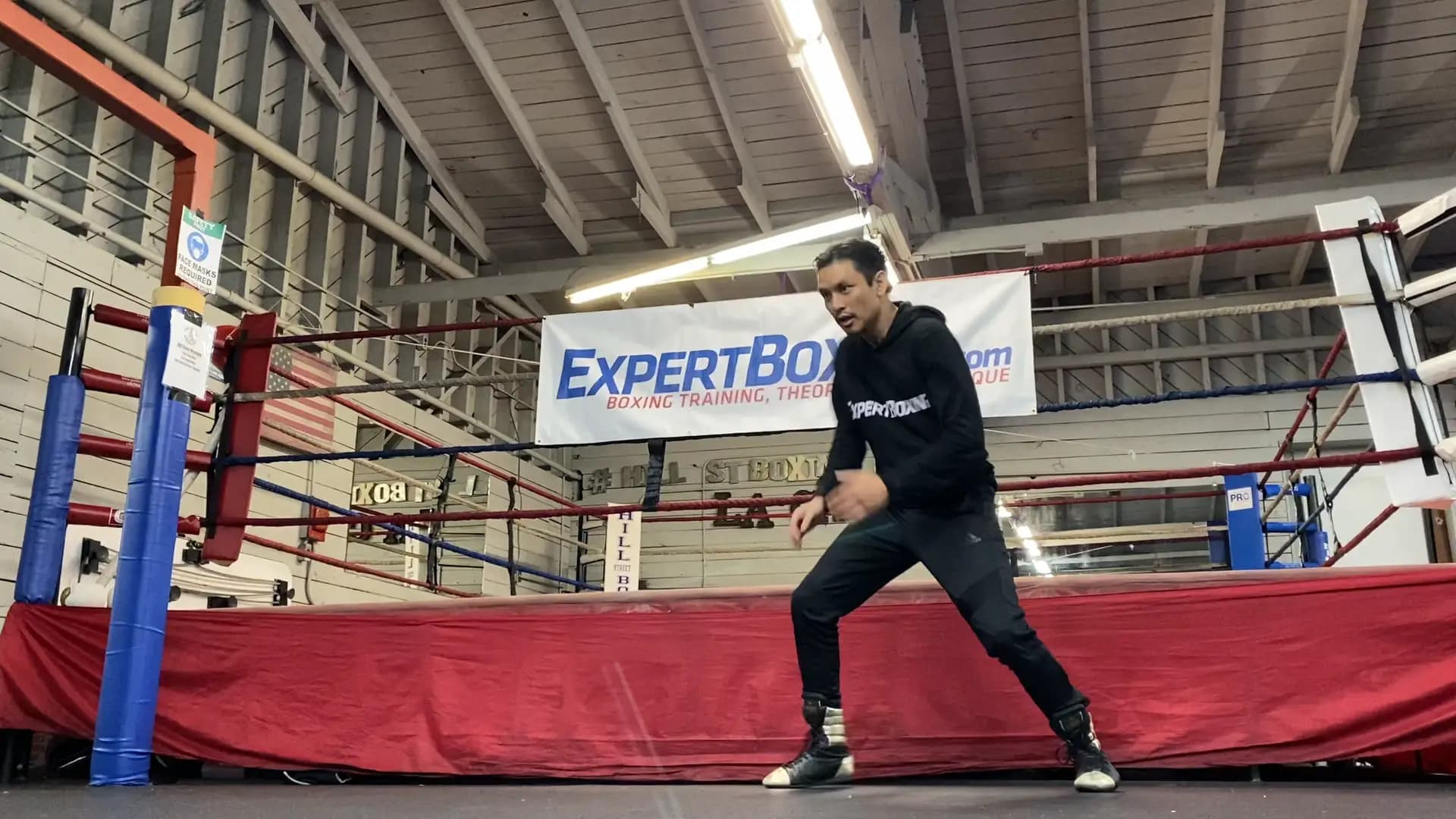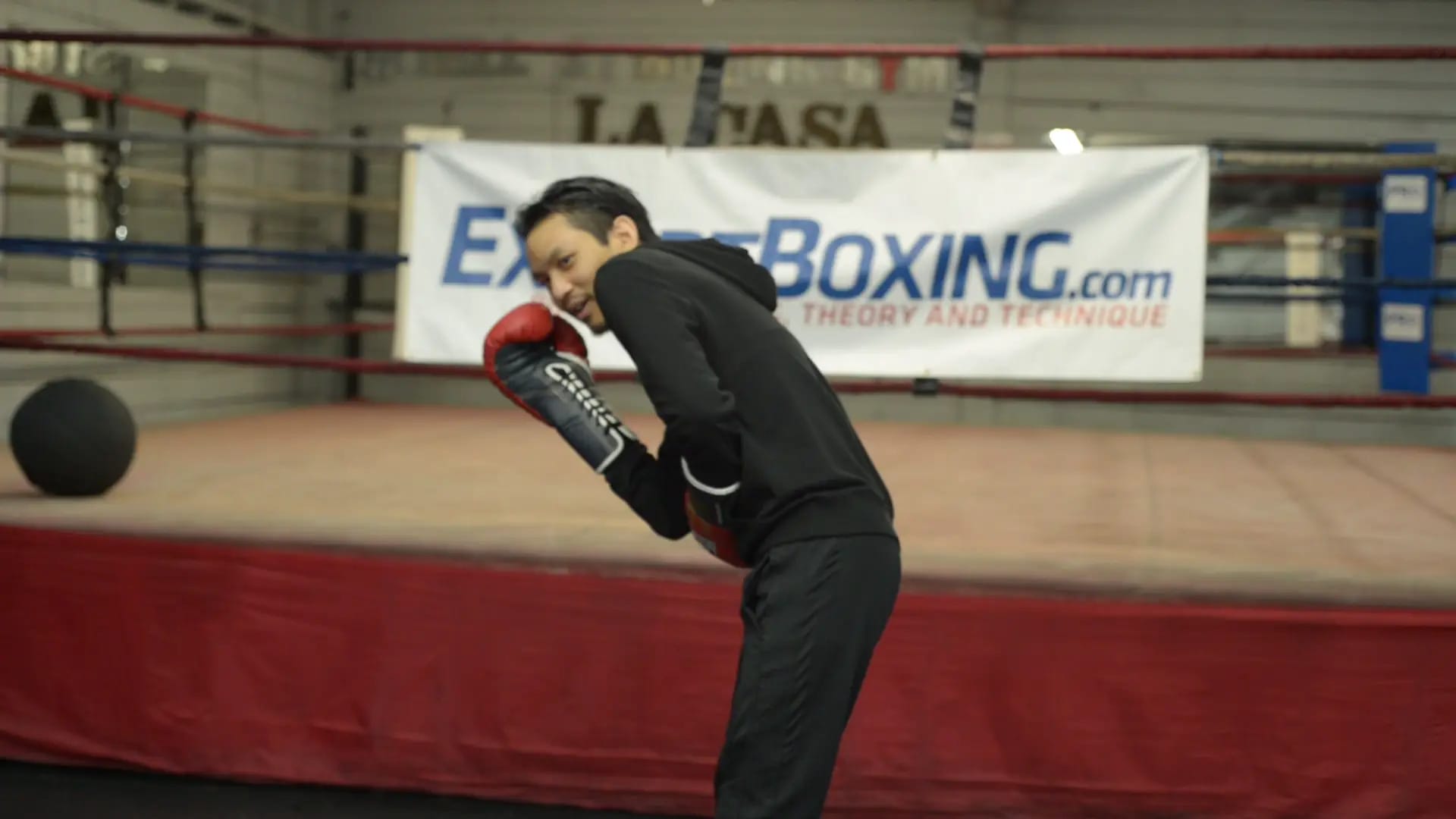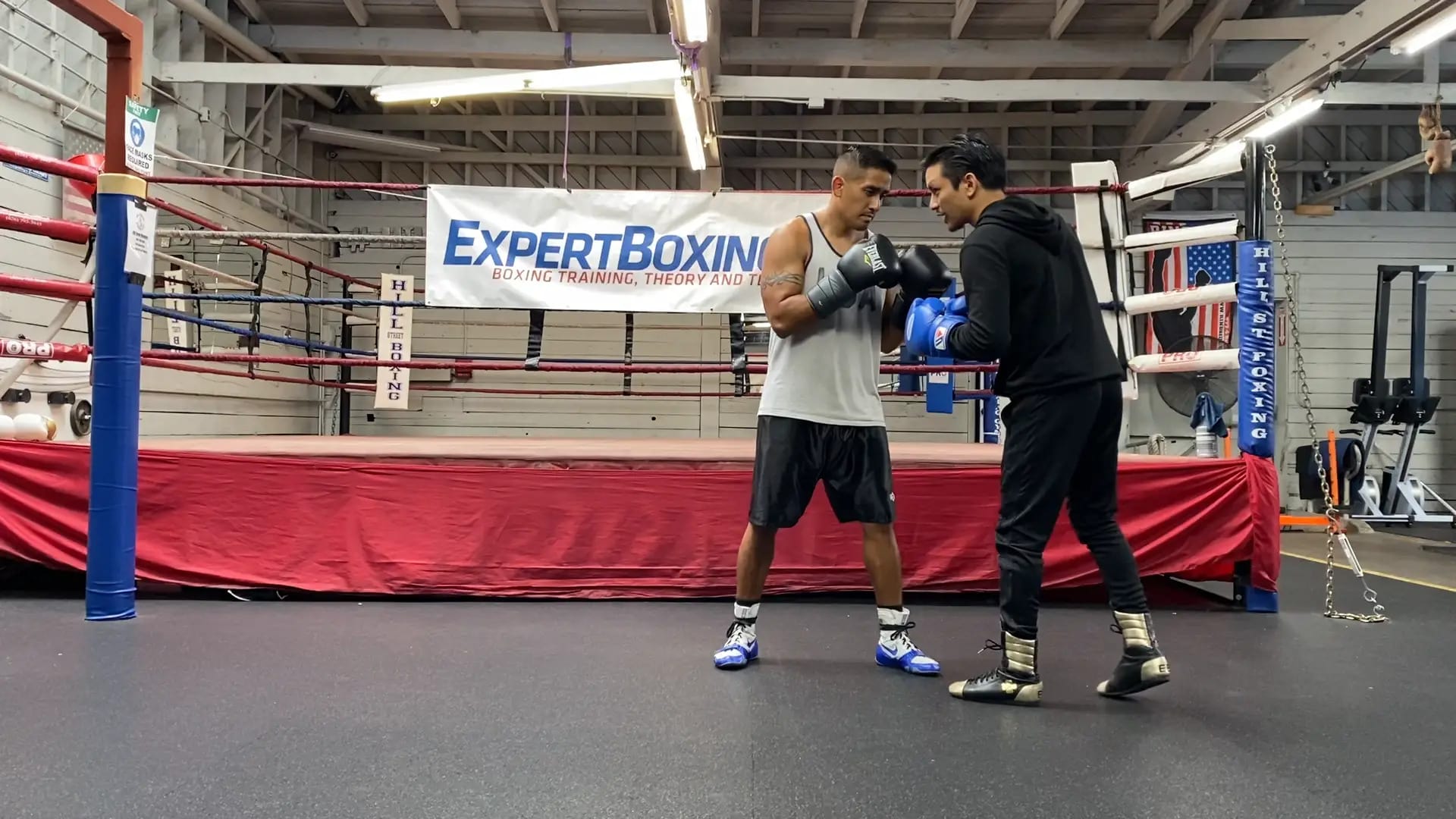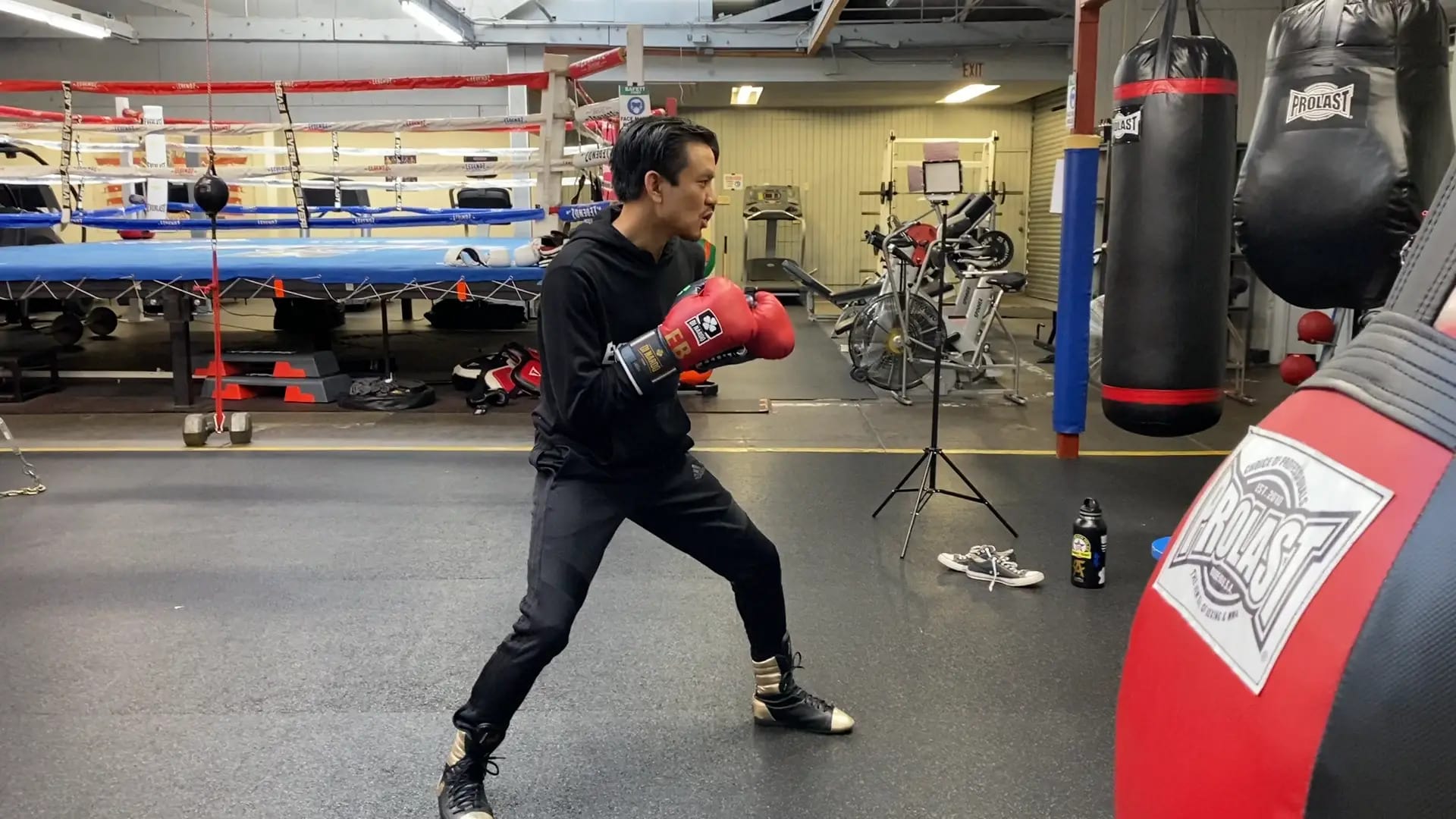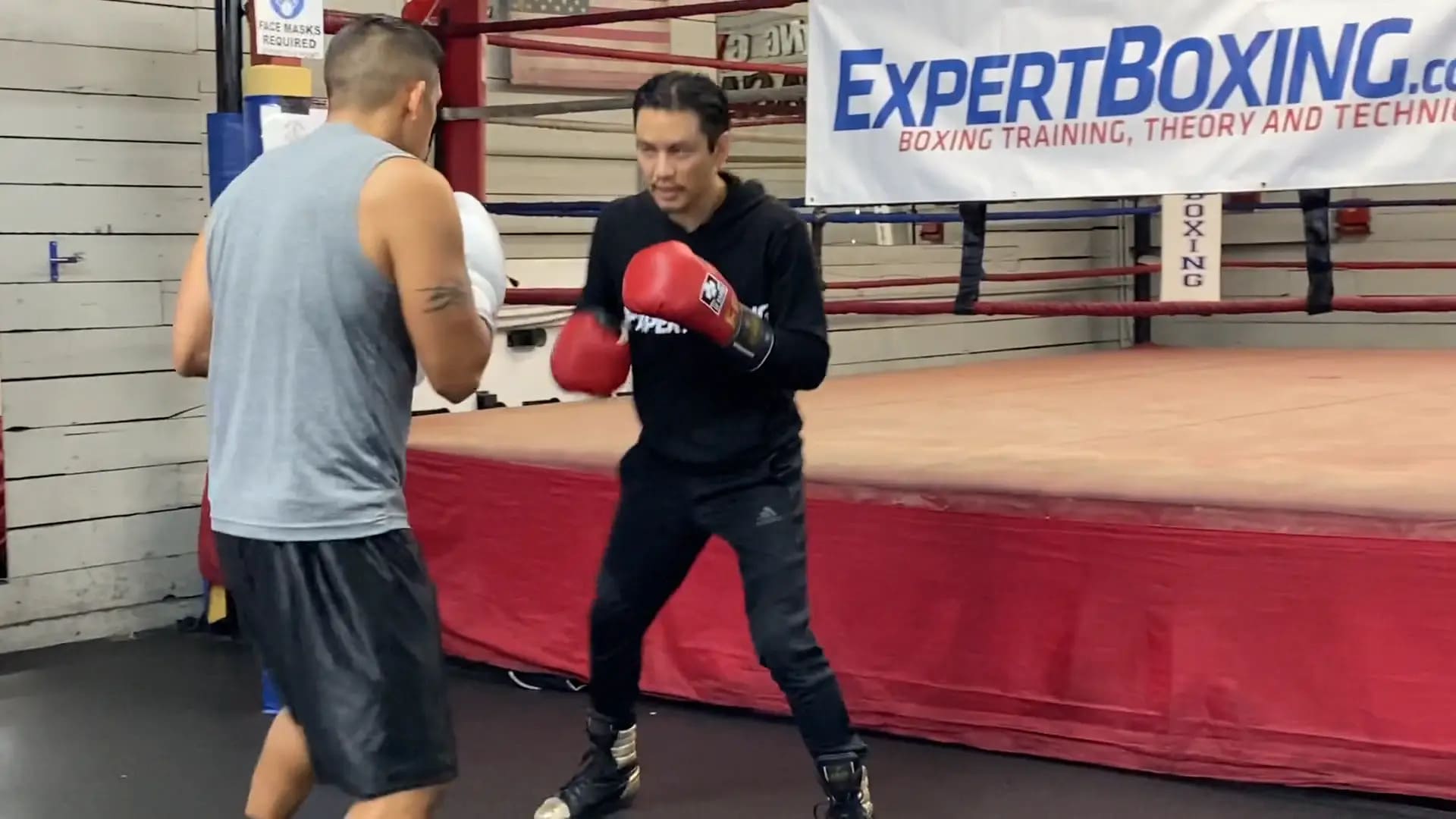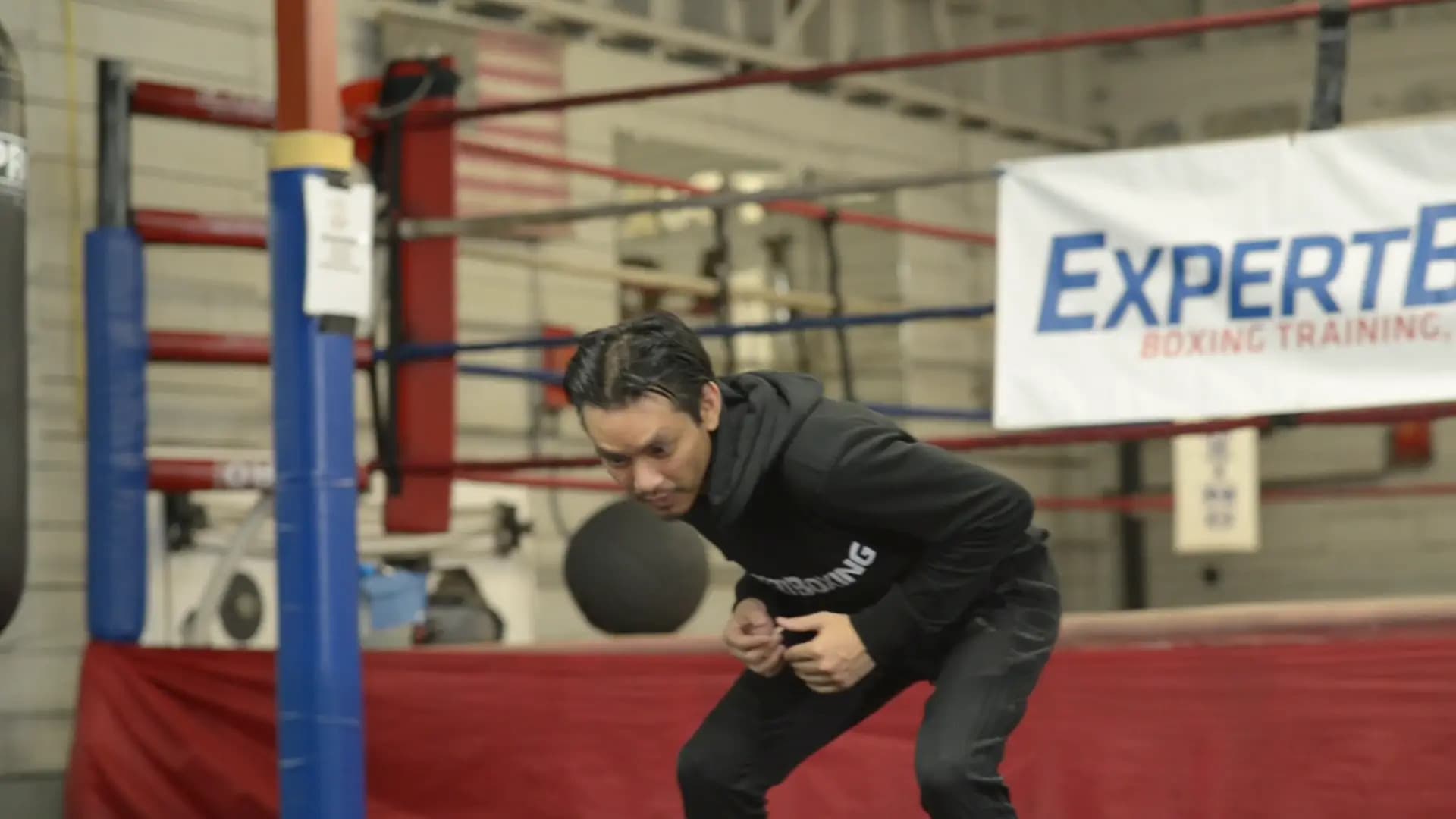Secrets to Boxing Defense
A 30-day intensive training program to develop a slick boxing defense.
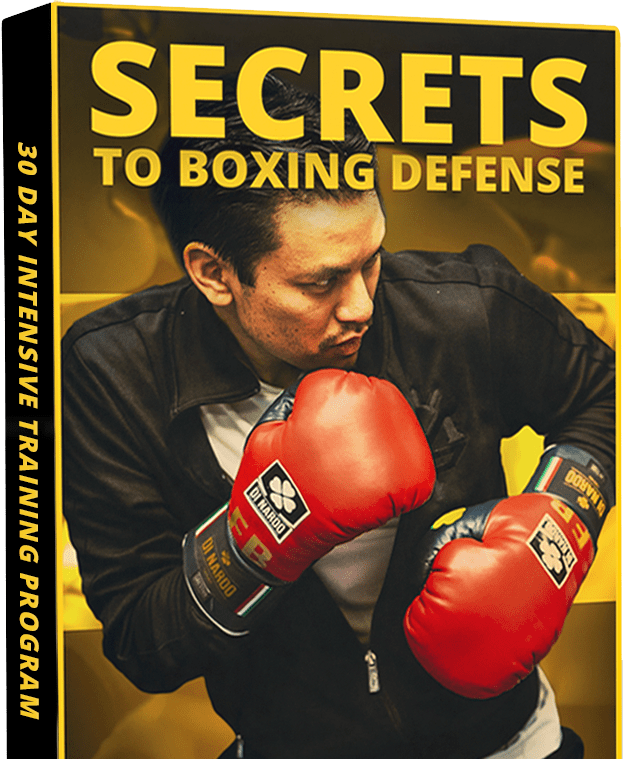
Over 100 defensive techniques!
Develop a slick boxing defense for fighting. Understand your opponents, see their punches, and frustrate them with efficient movement. Then set up counters and put THEM on the defensive!
Learn OVER 100+ defensive techniques, styles, drills, and tactics…to make yourself at home against any opponent!
I share all the defensive tactics I’ve learned (from 16+ years of boxing experience) in this 30-DAY intensive training program. 25+ HOURS of video instruction, and a 20-PAGE workbook to keep track and make notes of different concepts. Honestly…I think it’ll take you a year to really digest it all…but hey you ask for advanced, right?
- different defensive stances – to negate or bait attacks
- proper technique – for blocking, parrying, rolling, slipping
- slick footwork – in and out, lateral movement, pivots, and stance-shifting
- head movement – styles and rhythms to slip outside, inside, or under
- reflex training – to help you see punches (not memorize them)
- rhythm & timing – synchronize with incoming attacks naturally
- realistic drills – that make you flexible, NOT predictable
- counter-punching – using angles to set up different opponents
- fighting strategy – countering brawlers, frustrating punchers, out-hustling slicksters.
- defense mindset – feeling calm, confident, and comfortable against any opponent
FOREWORD: If you guys know me and how all my EB courses go, then you already know this is the most detailed thing you’ve ever seen on the topic. It’s taken years of outlining, months of shooting & editing, and a Corona downtime to have an available gym and demo partner. All my defensive knowledge given straight from my heart. I’m confident you’ll fall in love with the many gems I’ve dropped in there. There are so many nuances that you wouldn’t find anywhere else.
Can ANYONE develop slick boxing defense?
Why develop a slick boxing defense?
Most fighters are forced to be more defensive by their coaches. Constantly screamed at to keep their hands up and fight more intelligent (rather than emotional). Other fighters do it out of necessity…being smaller, shorter, or younger than their opponents…weak chin…or just want to protect their damn brain! And then you have the superstars who are already great and winning but want to hit the next level.
Good defense does so much more than avoiding damage. It allows you to read your opponent’s attacks and intentions, and to match or break their fighting rhythm. It provides comfort against any opponent. Creates time and space for you to think. Lets you set up exchanges on your terms. Defense controls fights by taking your opponent’s weapons away.
How much skills (or talent) do you need to move like a pro?
Sadly, many people don’t believe they can ever do it. I’ll tell you this now (and I mean it)…YOU can develop slick boxing skills. Yes—YOU! I don’t care how un-talented, un-natural, un-athletic, uncoordinated, out of shape, or how old you are. And I’m not just saying it because I’m selling an expensive defense program (haha).
I’ve not only trained tons of people online through my ExpertBoxing site, but also in person. I’ve seen it with my own two eyes. Fighters in every shape and style moving so much more elusively than you would ever imagine. Even people I thought would never be good end up proving me wrong. Just train with proper technique, don’t create mental limitations for yourself, and you’ll surprise yourself. I promise.
Does that mean a 50-year old couch potato can move like Floyd Mayweather after 3 months of training? Of course not. But you can learn the essence of how Mayweather moves and incorporate those fundamentals into your boxing style. You (probably) won’t do it exactly like him, but you’ll have your own respectable version of it.
I can help you.
I’ve been there and done that. I know what it’s like to be terrified of that one sparring partner. Or to keep getting hit with the same punch. Doubting myself and feeling like I’ll never be a pro. Nagging thoughts of not being talented enough. Even more agonizing to watch less-experienced fighters pick up things faster than I did.
Whatever negative thoughts you have right now…please push them aside and give yourself a chance. There are sooooo many techniques and drills out there that I’ve bet you’ve never tried. And a very good chance many of them will make things click for you. Not only will you finally learn the skills you’ve always wanted, but also become the fighter you’ve always wanted to be. And have oh-so-much more fun in the ring.
Don’t get me wrong. It’s STILL hard work. You still have to eat some shots. But this time around you’ll have a real game-plan. You’ll know what to look for, what to adjust, and how to visualize things so it comes out more natural. No matter what level, style, or body type…I can help you figure out a defensive style that works for you.
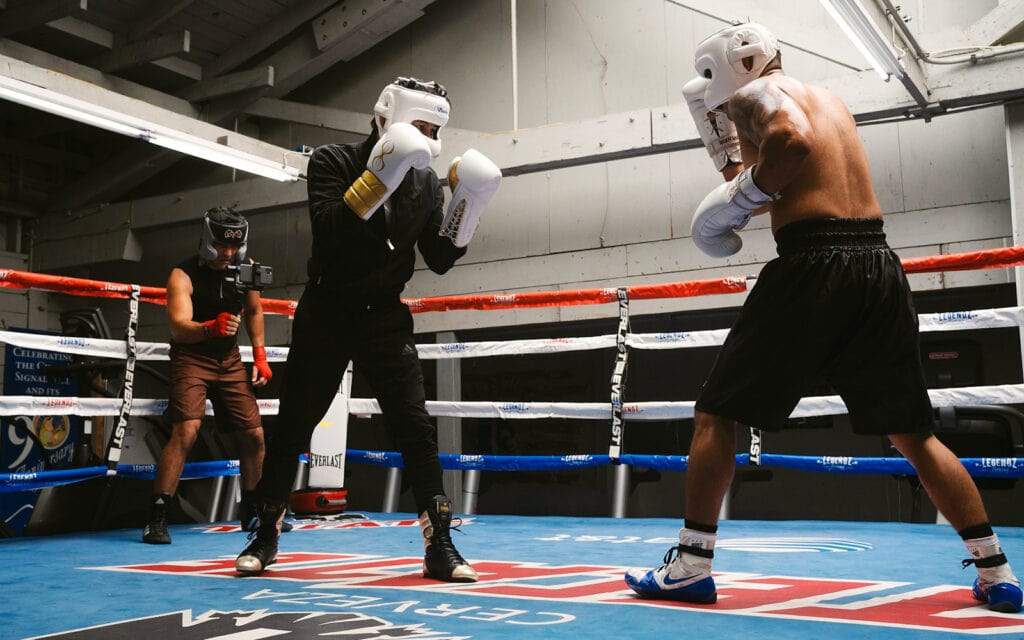
What boxing defense IS & ISN’T
Most people think boxing defense means “hands up” and head movement.
- hands up
- good head movement (whatever that means)
- footwork
- fast reflexes and slipping drills
- (maybe) copying the Mayweather shoulder roll
Some even claim “the best defense is a good offense”, or insinuate in other ways that attacking (and counter-punching) is the best defense. And while these sentiments aren’t wrong, they’re missing so many little details.
Defense is more than just posture, technique, and reflexes.
A real boxing defense has…
- VISION – being able to see punches before they are thrown.
- VERSATILITY – adjusting to different opponent styles, understanding how their attack angles change.
- RHYTHM – using your body’s natural rhythm to move easier when defending and countering.
- COMFORT – lets you relax, not feel like you have more work!
- AGGRESSIVE – great defense makes your opponents more defensive, not offensive!
Without vision and versatility, you’re just blindly memorizing defense habits. You still can’t see anything, and you still get hit when opponents don’t fight the way you were trained. Without rhythm, you use more energy and take yourself out of countering opportunities. What’s the point of that?
But more than anything, DEFENSE is a STATE-OF-MIND.
So many fighters have a defensive mindset that tells opponents – “I’m scared of fighting you. I don’t know what you’re doing next and I’m afraid you’ll hurt me.”
Defensive techniques don’t work if you’re showing fear.
Your defensive presence must still be an aggressive presence! You need to communicate confidence. That you are calm, calculated, and daring your opponent to make mistakes. That you are at home in the ring. This inner confidence comes with knowing exactly how to deal with your opponent.

Where most fighters fail in their defensive development
Too much focus on athleticism
Too much wasting time on flashy movements. They don’t understand the best techniques can only be felt (not seen). But of course “unseen” techniques don’t show well on camera and don’t inspire young fighters. As usual…the fundamentals are not appreciated until much later.
There’s also problems that come with having too much speed and overly-explosive movements. I see fighters falling off balance or ending up in positions where they can’t move or counter back. Even worse is when their defensive maneuvers take them OUT OF RHYTHM setting them up to get knocked out by their opponent’s follow-up punches.
Lack of versatility
When you only know one way to block (or one way to slip), you always run into a dead-end. That one technique works until it doesn’t. At which point, most fighters will still try the same but more frantic…and it doesn’t help. It uses more energy and makes them even more vulnerable.
All attacks have nuances. There are probably 20 ways to throw the jab, right? So you must know 20 ways to evade the jab as well! You shouldn’t move just to avoid getting hit. You have to move into new angles, for countering, or baiting different follow-up punches, or to communicate something to your opponent.
Your movements must show that you are more skilled, not more scared.
Lack of vision (over-focusing on reflexes)
Many fighters think great defense requires great reflexes or speed. And while they do help, they aren’t necessary. In fact, the most skilled defensive specialists are the smoothest and calmest movers you’ll ever meet! (They almost DON’T move.)
So how does THAT work? Easy! They do it with great vision. They can see everything you want to do before you do it. They pick up on your movement cues earlier. They know what punches look like before the arm is fully extended. And it’s not memory, ok? It’s vision! This incredible vision is what makes them so slick. If you only see punches when they’re thrown, you are too damn late already!
I’ll impart several training methods to give you this vision. Defense is so much easier once you can see what your opponent is doing. Want to know something interesting?…
Opponents hold back when (they realize) you SEE their punches! 😉
How do you develop a serious boxing defense?
First, you need a solid feedback cycle:
- Learn new technique.
- Practice it in realistic drills.
- Try it out in sparring.
- Get feedback and make adjustments.
- REPEAT…
Sure…it also helps to have good genetics, speed and reflexes, a super strict father/coach, and doing hundreds of drills everyday. Training in a gym with world champions is also helpful! But I’m confident anyone can develop their skills if they at least practice new techniques and try out on a live partner.
Second, you need variety of training.
- Different techniques.
- Different tactics and styles.
- Different coaches and sparring partners.
The more exposure to different things, the more comfortable you become. You develop confidence with experience. Nothing scares you when you’ve seen it already. Fear and discomfort are often rooted in unfamiliarity.
Third, you need to understand opponents.
Basic defense only avoids punches.
True defense understands opponents.
Defense is more than simply avoiding punches. You have to know how opponents think. How they fight, how they attack, what angles they like to use. Even better if you can pick their defense apart. This is the bare minimum you need to sit in the pocket with cold killers.
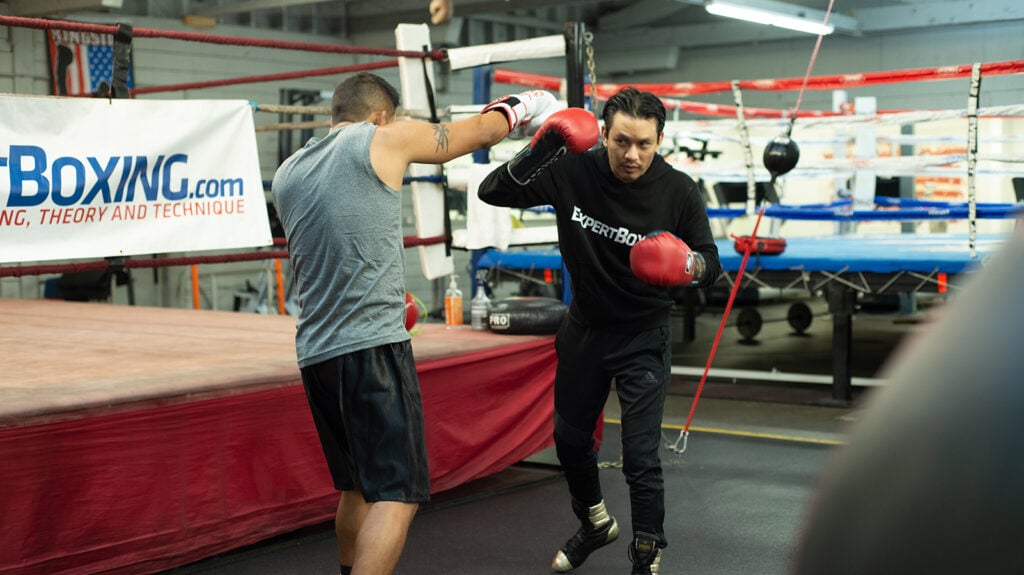
What makes STBD different from other defense programs?
DETAILED – technique, realistic drills, nuances, mindset
If you guys know me and how all my EB courses go, then you already know this will be the most absolute detailed thing you’ve ever seen on the topic. I cover everything there is. I talk theory and mindset, I go over hundreds of techniques, demonstrate them in realistic drills, and show you all the important nuances from various angles.
You’ll learn not only the right way to do things, but also all the wrong ways. I want you to walk away crystal clear on what is correct or not, and what makes it work. And of course, I show you areas where you can alter for your own personal style.
TRANSITIONS – from defense to offense
Because many defensive techniques don’t connect all the dots. They show you cool tricks to evade single punches from this angle or that angle. But they don’t help you string movements together, to avoid follow-up punches AND set up your counters.
The truth is there is no defense that that will keep you 100% safe. And no opponent that you can keep away for the whole fight…unless you fight back. And therefore, no defensive program is complete until it shows you how to go from defense to offense. Fancy blocking, rolling, and slipping alone aren’t good enough to keep legit opponents away.
STRATEGY – for different opponents/styles
You cannot use the same defense strategy for all fighters. What may be “good technique” for one opponent can leave you vulnerable against another! You need to sense how different opponents attack and defend. And what punches they’re most vulnerable to.
More than anything, you have to feel comfortable against any opponent style. This is done by understanding (and recognizing) their traits. And then having multiple ways to deal with their patterns. As the saying goes…styles make fights. And technical mastery doesn’t help you if you have the wrong strategy for your opponent!
Easier said than done. It took me many years of training, drills, techniques, exercises, and of course….countless brutal sparring sessions to know what I know now. But at last…I am comfortable in the ring. I can be out of shape with zero conditioning and still step in with younger bigger guys, and still be comfortable. And STILL have fun until the last bell.
What’s inside the training program
Short demo clips. Click any video to play.
(NOTE: actual camera angle will be straight on and show full body.)
30 days of video instruction
- 1500+ minutes of total footage
- Online video course – stream off your browser, instead of eating up storage space
- Workbook – listing all concepts and for you to make notes
In-depth training
- Hundreds of techniques
- Hundreds of drills (with and without a partner)
- Technical breakdowns
- Theory explanations
- Live demonstrations with a partner
- Strategies against different fighting styles
- Virtual sparring each day (practice even without a partner)
- Too many things to list…please see daily topics and subtopics below
People I MOST recommend this training program for…
- Aspiring boxers – you love boxing and really want to learn every bit of it. See a structured overview of every skill you need to reach the advanced levels.
- Serious boxers – you’re already competing (amateur or pro). This program can open your mind to new defensive styles, movement technique, and overall way of thinking.
- Coaches – this program can help you demonstrate and explain the most complex parts of boxing technique to fighters. It can teach (or remind) you of all the little nuances to help fighters visualize things correctly.
- MMA or TMA – get a convenient overview of many different boxing styles all in one place. Then incorporate the most useful techniques and strategies into your existing style.
- Street fighters – yes, you can still get many helpful tactics. But keep in mind most street fights don’t use any advanced tactics and strategy. Just unplanned brawling based on emotion rather than intelligence.
People I DON’T recommend this training program for…
- Casual practitioners – if you’re not a serious fighter, you really don’t need this at all whatsoever. It is so painfully in-depth and might even kill the joy of boxing for you. There are so many technical nuances you wouldn’t ever use unless you’re in the ring fighting for your life.
- Lazy people – if you’re looking for a shortcut, this program is NOT it. Everything here will make your head dizzy and easily take you a year to master. If you want a shortcut, maybe taking lessons with a professional boxer in person is easier!
- It cannot substitute sparring – real fighting experience can you teach you things my program cannot. But alas, I’m biased to believe to believe mine is the best program out there.
Secrets to Boxing Defense
BUY NOW FOR $295
- 25+ HOURS of video
Nearly 1500 minutes of technical instruction broken down into a 30-day intensive training program. Learn over 100+ defensive techniques to improve your boxing defense! - 20-page workbook
All the defensive topics, techniques and drills conveniently listed in a helpful PDF. Print it out, follow along, and make notes. - NO EQUIPMENT NECESSARY
It’s most ideal to have a partner and punching bag, but you can learn even alone and with nothing. - THIS IS A STREAMING COURSE
No physical items are shipped, and also no downloads allowed. (I no longer want to deal with large video file hosting, it’s 400GB worth of videos.) You’ll receive a member login after signing-up, where you can stream your course videos. You need internet to watch these videos.
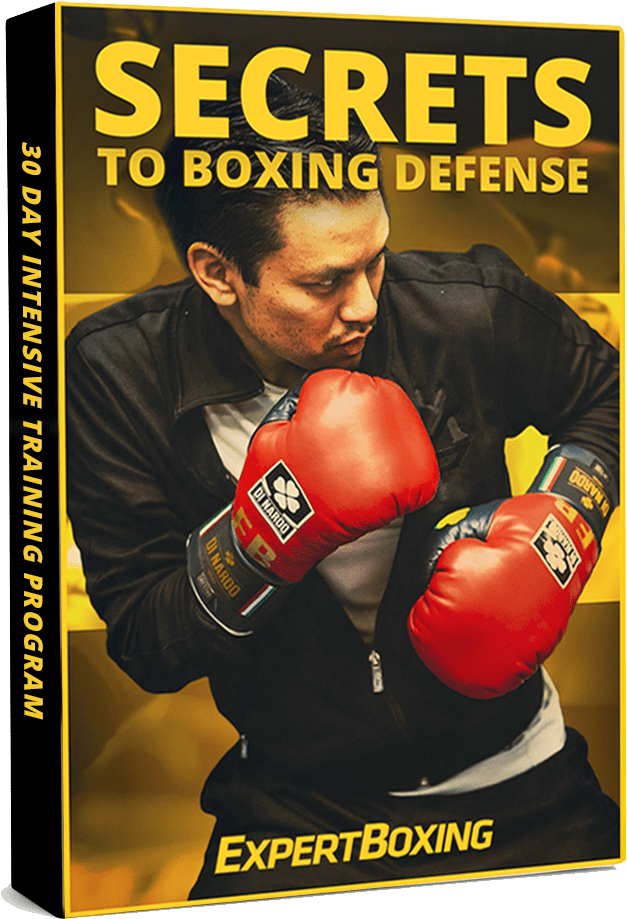
GET A LIFETIME EB GOLD MEMBERSHIP! ONLY $595
The EB Gold membership gets you access to all EB courses (including this one) for FREE!
See more information on the EB membership.
Reviews
Skyler Carson (USA)
“I started off my amateur career with an 0-2 losing record because I lacked confidence and knowledge about the sport. I stopped boxing until I turned 18, two years later. Being someone who loves technology, Google is my go-to place where I found Expert Boxing.
I can honestly say that Expert Boxing has helped me grasp and understand boxing early in my career and understand the fundamentals. Ended my amateur career as 20 – 7 and won multiple titles before turning pro. I can say Expert Boxing has definitely been a factor in my success and progression in the sport.”
Kacper Dudzinski (PL)
“Welsh champion in 2014, finalist in 2015. Had 21 amateur bouts (won 19, lost 2) and got 2nd pro fight in 3 weeks time. Apart from being involved in so many gym sparring/training with world class amateurs and pros, ExpertBoxing probably played the biggest role in my career as I was following the tips, corrections and little adjustments through the last 5 years of my career. Funny enough sometimes in changing room before a fight, instead of listening to the trainer I was thinking about all of Johnny’s advices and stuff and it’s even more funny that it usually worked.
The way he presents stuff is so much more advanced and helpful as is not as obvious as all other cheap boxing videos you can find on Youtube. His videos are something different as he is describing the way of feeling stuff,…
(Full review)Scott Murray (UK)
My boxing background:
I’ve had had 40 amateur boxing fights. I was ready to turn professional in my mind and my coach offered me the opportunity, however due to a bad knee injury that had a lot of cartilage removed leaving me with almost bone on bone, I couldn’t go ahead. I had to surgeries over 2 years and had to train myself to walk again twice. Had my own boxing club and coaching business also, used where I used all the principles to teach all my clients and fighters. If it was not for the lack of any internal support in my lead knee, I would be a professional boxer right now as my full time job and passion, as all the guys that I used to spar and fight with are now good professionals, some elite world class level and future world champions to be.
Punching power secrets course was…
Jordan Johnson (USA)
“Hey Johnny,
I’ve been following your blog/youtube since my first day in boxing. This past April I won the Sr. Novice Heavyweight Golden Gloves in Chicago. I just want to say your vids have been helpful and inspirational along the way. I’ve had to learn the techniques you talk about the hard way in the gym. But you’ve always been another great resource for knowledge.
Your footwork dvds will help me win the advanced division next year! I’ve been practicing the principles from the first 2 days and already noticed a huge improvement in my confidence, footwork, and head movement due to my new understanding of my “center”. I now understand one of the huge differences between me and the pros I’ve spared with is their relaxation and use of their center of gravity. My legs have gotten very…
(Full review)Misha K. (RU)
Man it’s so much information in your new video course. Like A LOT just WOW. Like i can just see how the trainers here teach people just one technique and say it’s the only right technique but I watch your videos and I see that that techniques is just one of like dozens and by sticking to only that one technique you limit yourself A LOT. It’s crazy good, man.
That’s hands down the best product out there. It is just worth paying 200-500 dollars and i think when people realise how valuable that info is they will buy it for sure.
Juan (MX)
As always: GREAT. I have made sparring 3 times, last time my trainer said to me “hey Juan you do some movements like a professional but sometimes u fight terrible” what I try to say is that those movements are thanks to your videos or advices, on the other hand IM A BEGGINER.
thanks again Johnny.
KD
I have only watched few videos of Secrets to Boxing Defense but so impressed … the knowladge Johnny Nguyen has and the way he share it with us all is incredible . Defo material for someone who never box , as same as for someone who boxed all theirs life 👊👊
Here's what you get…
Here is the topic list and daily breakdown of the training program. I’ve included a few highlights from each day—don’t look too closely—I purposely didn’t list everything that’s included in my videos. 😉
- Intro to STBD
- Boxing Defense Theory
- 1st rule of defense – common mistakes fighters make when warming-up.
- 2nd rule of defense – neutral axis awareness and strengthening your fighting stance.
- Importance of sparring – standing on the right part of your feet for balance and power.
- DRILL #1 – neutral fighting stance – common body positions that weaken your stance and punches.
- DRILL #2 – eyebrow view – fundamental principles on creating power through relaxation.
- DRILL #3 – calm breathing & constant vision – to improve punching power.
- DRILL #4 – wide vision – how it develops punching technique and makes you a more natural puncher.
- VIRTUAL SPARRING
- What is blocking?
- Basic blocking technique
- 4-QUADRANT blocking technique
- Push-blocking
- Techniques for blocking combinations
- Headgear visibility
- Blocking technique – ALL PUNCHES
- DRILL #1 – blocking combinations
- DRILL #2 – block & counter
- VIRTUAL SPARRING
- What is parrying?
- Basic parrying technique -shifting blocks
- Hand parrying technique – DOWN, SIDE, UP, CIRCLE, LOW
- MIRROR-HAND vs CROSS-HAND parrying
- Parrying at different distances
- DRILL #1 – basic parry
- DRILL #2 – parrying & blocking/strong>
- DRILL #3 – parrying & countering
- VIRTUAL SPARRING
- What is rolling? something
- Difference between Philly Shell vs Shoulder Roll
- Basic rolling technique – rolling rhythm
- DEFLECTING vs BLOCKING
- Rolling and Punching
- Tilting and stepping
- Chin position during shoulder roll
- Rolling technique – ALL PUNCHES
- DRILL #1 – basic roll
- DRILL #2 – straight vs curved
- DRILL #3 – tilted rolls
- DRILL #4 – rolling & countering
- VIRTUAL SPARRING
- What is slipping?
- Basic slipping theory (GOOD vs BAD technique)
- Basic slip technique
- The TRIANGLE slipping formation
- Slipping outside – HEAD PUNCHES
- Slipping outside – LOW PUNCHES
- Slipping and countering
- The KNOCKOUT danger of slipping and countering
- DRILL #1 – shadowboxing with mirror
- DRILL #2 – shadowboxing with slip rope
- DRILL #3 – shadowboxing with partner
- MITTS #1 – blocking
- MITTS #2 – parrying
- MITTS #3 – rolling
- MITTS #4 – slipping
- VIRTUAL MITTS #1 – blocking & parrying
- VIRTUAL MITTS #2 – rolling & slipping
- VIRTUAL MITTS #3 – punching & slipping
- VIRTUAL SPARRING
- What can advanced blocking do?
- Solid Axis Stability
- LAT block vs SHOULDER block
- Blocking straight vs curved punches
- Precision push-blocking
- Forearm and elbow block
- Balance manipulation
- Aggressive blocking psychology
- DRILL #1 – stiff axis
- DRILL #2 – push block
- DRILL #3 – block & counter
- DRILL #4 – weight shift while blocking
- DRILL #5 – default blocking combo
- VIRTUAL SPARRING
- What can advanced parrying do?
- Long-arm Parry
- Parrying after punching
- Cross-arm Parry
- Low Parry
- DRILL #1 – long and pre-emptive parry
- DRILL #2 – cross parry
- DRILL #3 – low parry
- DRILL #4 – default parry combo
- VIRTUAL SPARRING
- What can advanced rolling do?
- Philly Shell boxing style & tips
- Philly Shell escape angle
- Arm deflection
- Head deflection
- Rolling UNDER punches
- Stance-switching while rolling
- DRILL #1 – constant rolling flow
- DRILL #2 – default roll combo
- VIRTUAL SPARRING
- What can advanced slipping do?
- 2-SLIP setup
- Slipping INSIDE vs OUTSIDE
- The Double Slip
- Body shot slipping – hip pullout
- Upper body – counterweight rhythm
- DRILL #1 – front & back triangles
- DRILL #2 – two slip setup
- DRILL #3 – old school tire drill
- DRILL #4 – slipping the jab, inside & outside
- DRILL #5 – double slip
- VIRTUAL SPARRING
- Defensive Footwork Theory
- Holding ground & body language
- The Half-Step
- The Quarter Turn – linear vs pivot
- Footwork with Blocking
- Footwork with Parrying
- Footwork with Rolling
- Footwork with Slipping
- Transitioning punches with footwork
- Importance of shadowboxing
- DRILL #1 – holding ground
- DRILL #2 – half step
- DRILL #3 – quarter pivot
- DRILL #4 – footwork with defense
- DRILL #5 – slow exchange
- VIRTUAL SPARRING
- What is your core?
- WHAT & WHERE is your core?
- Finding your core level
- Controlling your core level
- Moving from the core
- Core density
- Core release
- DRILL #1 – core movement
- DRILL #2 – core habit awareness
- DRILL #3 – core level
- DRILL #4 – changing density
- VIRTUAL SPARRING
- Why are hand positions so important?
- Different hand positions in boxing
- Long-arm pushoff technique
- Forearm bar
- Hand-slipping rhythm
- Hand-tilt variations
- Clinch tactics
- Spin mechanics
- Countering spins and clinches
- DRILL #1 – different hand positions
- DRILL #2 – long arm pushoff
- DRILL #3 – forearm control
- DRILL #4 – clinching and wrestling
- VIRTUAL SPARRING
- Why is head movement so important?
- Head Movement Technique #1 – CHEST BOUNCE
- Internal Bounce Direction
- Head Movement Technique #2 – HIP BOUNCE
- Hand position when slipping
- Rhythm change-ups
- Head movement transitions – 3 AXIS
- Make your own head movement patterns
- DRILL #1 – chest bounce
- DRILL #2 – hip bounce
- DRILL #3 – head movement dance
- VIRTUAL SPARRING
- What makes slick footwork?
- Principles of good footwork technique
- Controlling your footwork distance
- Head placement for footwork
- Rhythmic footwork efficiency
- Recycling energy
- Transition from head movement to footwork
- Using shoulders for pivots
- Quarter Pivot Rhythm
- Finding your head movement rhythm
- DRILL #1 – jumping rope
- DRILL #2 – move small or relaxed
- DRILL #3 – punch and pivot
- DRILL #4 – punch then footwork
- DRILL #5 – metronome footwork dance
- VIRTUAL SPARRING
- Principles of energy efficiency
- RHYTHMIC breathing vs SHARP breathing
- Using TIMING to create power
- Using DIRECTION to surprise opponents
- Changing rhythm – without losing rhythm
- DRILL #1 – natural breathing rhythm
- DRILL #2 – hesitation breath
- DRILL #3 – relaxed power timing
- DRILL #4 – surprise direction
- VIRTUAL SPARRING
- When do we need brawling angles?
- Default brawling stance
- Brawling attack strategy
- Brawling defense strategy
- Angled vision
- Evading jabs (as brawler)
- Evading rights (as brawler)
- Evading hooks (as brawler)
- Evading uppercuts (as brawler)
- Evading body shots (as brawler)
- DRILL #1 – evading punches
- DRILL #2 – brawling vs brawler
- DRILL 3# – brawler vs boxer
- VIRTUAL SPARRING
- When do we need outside boxing angles?
- Default outside boxing stance
- Keep arms busy, but accurate
- Outside boxer attack strategy
- Outside boxer defense strategy
- Evading jabs (as outside boxer)
- Evading rights (as outside boxer)
- Evading hooks & uppercuts (as outside boxer)
- Evading body shots (as outside boxer)
- DRILL #1 – jabs vs jabs
- DRILL #2 – jabs vs hooks
- DRILL #3 – jabs vs rights
- DRILL #4 – jabs vs body shots
- VIRTUAL SPARRING
- When do we need stalking angles?
- Low stalker stance
- High stalker stance
- Difference between Stalkers and Brawlers
- Requirements to be a stalker
- Stalker attack strategy
- How to pressure opponents
- Stalker defense strategy
- Evading jabs (as stalker)
- Evading rights (as stalker)
- Evading power shots (as stalker)
- Evading body shots & uppercuts (as stalker)
- DRILL #1 – cut off the ring
- DRILL #2 – touch jab vs catch-n-jab
- DRILL #3 – forced block vs catch-n-shoot
- DRILL #4 – body shots vs catch-n-shoot
- VIRTUAL SPARRING
- When do we need retreat angles?
- Important factors when retreating
- Different retreating stances
- Retreating from center ring
- Temporary southpaw tactics
- The Art of Retreat
- DRILL #1 – constant circling
- DRILL #2 – backwalk
- VIRTUAL SPARRING
- When do we need escape angles?
- How close should you go to the ropes?
- Different escape stances
- Defense strategy on the ropes
- Countering strategy off the ropes
- Escape off the ropes
- Escape out of the corner
- Keep weight on the front foot
- DRILL #1 – rope escape vs the 1-2
- DRILL #2 – corner escape vs counters
- VIRTUAL SPARRING
- Understanding the brawler’s mentality
- Defense strategy against brawlers
- Fighting stance (against brawlers)
- Jab strategy (against brawlers)
- Power punching strategy (against brawlers)
- Escape strategy (against brawlers)
- Do you really need constant movement?
- Counter-punching strategy (against brawlers)
- DRILL #1 – lead shots vs brawler head movement
- DRILL #2 – punching down vs low brawler
- DRILL #3 – rope escape vs brawler
- VIRTUAL SPARRING
- Understanding the puncher’s mentality
- Defense strategy (against punchers)
- Fighting stance (against punchers)
- Setting the rhythm
- Tactics for staying busy
- Evading the big punches
- Fighting strategy (against punchers)
- Longterm strategy (against punchers)
- DRILL #1 – boxer vs puncher
- DRILL #2 – catch and shoot
- DRILL #3 – countering the puncher
- VIRTUAL SPARRING
- Understanding the slickster’s mentality
- Fighting stance (against slicksters)
- Fighting strategy (against slicksters)
- POWER slickster vs SKILL slickster
- Attack rhythm (against slicksters)
- Catch the slickster timing
- DRILL #1 – open hand contact
- DRILL #2 – open stance vs slickster potshot
- DRILL #3 – baiting vs slickster
- VIRTUAL SPARRING
- Understanding the awkward fighter
- Defense strategy (against awkward fighters)
- What makes fighters awkward?
- Figuring out awkward opponents
- Attacking awkward fighters
- DRILL #1 – straight vs wide punches
- DRILL #2 – potshot uppercuts
- VIRTUAL SPARRING
- Understanding the southpaw’s mentality
- Southpaw angle visualizations
- Defense strategy (against southpaws)
- Jab strategy (against southpaws)
- Back hand strategy (against southpaws)
- Front foot position
- Should you ever turn (or practice) southpaw?
- DRILL #1 – jab battle
- DRILL #2 – crosses and defense
- DRILL #3 – footwork battle
- VIRTUAL SPARRING
- Why is countering important for defense?
- Counter-timing for blocking
- Block-countering (same time)
- Block-countering (off time)
- Block-countering (combo time)
- Counter-timing for parrying
- DRILL #1 – same time counters
- DRILL #2 – off time counters (catch and shoot)
- DRILL #3 – combo time counters
- DRILL #4 – touch parries at center ring
- DRILL #5 – touch parries off the ropes
- VIRTUAL SPARRING
- Counter-timing for rolling
- Roll-countering (same time)
- Roll-countering (off time)
- Roll-countering (combo time)
- Counter-timing for slipping
- Slip-countering (same time)
- Slip-countering (off time)
- Slip-countering (combo time)
- DRILL #1 – roll countering (same time)
- DRILL #2 – roll countering (off time)
- DRILL #3 – slip countering (same time)
- DRILL #4 – slip countering (off time)
- VIRTUAL SPARRING
- Body positioning for counter-punching
- Experimenting outside the diagonal position
- Explore NOT shifting weight
- Bounce and HOOK
- Bounce and CROSS
- Shuffle Cut Technique
- Head position on step-back counters
- DRILL #1 – step and hook
- DRILL #2 – step and cross (or hook)
- DRILL #3 – shuffle cut
- VIRTUAL SPARRING
- Defensive training cycle
- How to develop defensive reflexes
- Body mechanics for defense
- Defensive vision and reaction drills
- Drills for developing natural body movement
- How effective are non-boxing reaction drills?
- How to be flashy
- Tips to shortcut your technique development
- Drills for today
- Aggressive defense attitude
- Self-control for a fighter
- How to rest when on defense
- Survive a losing fight
- Being open-minded
- Enjoy the art of boxing
- Thank You
PS: Still have questions about “SECRETS to Boxing Defense”?
Contact me and I’ll answer it right away. It’s an incredible course with MANY techniques.
